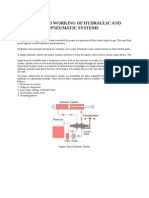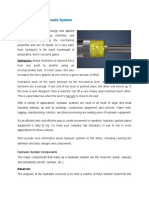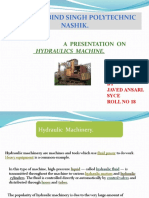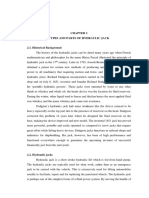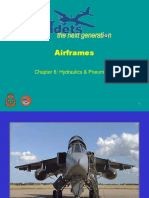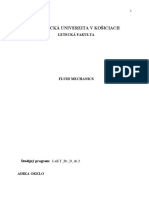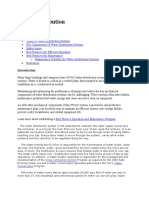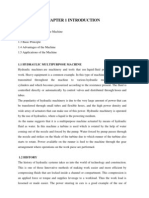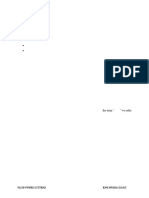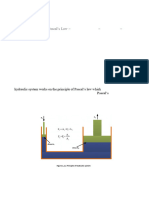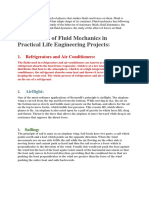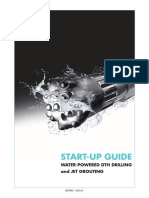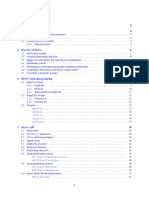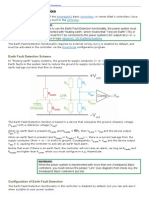Basic Hydraulics: States of
Basic Hydraulics: States of
Uploaded by
Pietr SemiCopyright:
Available Formats
Basic Hydraulics: States of
Basic Hydraulics: States of
Uploaded by
Pietr SemiOriginal Title
Copyright
Available Formats
Share this document
Did you find this document useful?
Is this content inappropriate?
Copyright:
Available Formats
Basic Hydraulics: States of
Basic Hydraulics: States of
Uploaded by
Pietr SemiCopyright:
Available Formats
1
BASIC HYDRAULICS
Fluid power systems have developed rapidly over the past 35 years. Today, fluid power technology is used in every phase of human existence. The extensive use of hydraulics to transmit power is due to the fact that properly constructed fluid power systems possess a number of favorable characteristics. They eliminate the need for complicated systems of gears, cams, and levers. Motion can be transmitted without the slack or mechanical looseness inherent in the use of solid machine parts. The fluids used are not subject to breakage as are mechanical parts, and the mechanisms are not subjected to great wear. The operation of a typical fluid power system is illustrated in Figure 1-1. Oil from a tank or reservoir flows through a pipe into a pump. An electric motor, air motor, gas or steam turbine, or an internal combustion engine can drive the pump. The pump increases the pressure of the oil. The actual pressure developed depends on the design of the system. The high-pressure oil flows in piping through a control valve. The control valve changes the direction of oil flow. A relief valve, set at a desired, safe operating pressure, protects the system from an overpressure condition. The oil that enters the cylinder acts on the piston, with the pressure acting over the area of the piston, developing a force on the piston rod. The force on the piston rod enables the movement of a load or device.
STATES OF
MA~ER
The material that makes up the universe is known as matter. Matter is defined as any substance that occupies space and has weight. Matter exists in three states: solid, liquid, and gas. Each has distinguishing characteristics. Solids have a defined volume and a definite shape. Liquids have a definite volume, but take the shape of their containing vessels. Gases have neither a definite shape nor a definite volume. Gases not
Fluid Power Dynamics
Figure 1-1 Basic hydraulic system.
only take the shape of the containing vessel, but also expand to fill the vessel, regardless of its volume. Examples of the states of matter are iron, water, and air. Matter can change from one state to another. Water is a good example. At high temperatures, above 212" Fahrenheit (OF), it is in a gaseous state known as steam. At moderate temperatures, it is liquid, and at low temperatures, below 32"F, it becomes ice, a solid. In this example, the temperature is the dominant factor in determining the state that the substance assumes. Pressure is another important factor that will affect changes in the state of matter. At pressures lower than atmospheric, 14.7 psi, water will boil and thus change to steam at temperatures below 212F. Pressure is also a critical factor in changing some gases to liquids or solids. Normally, when pressure and chilling are both applied to a gas, the gas assumes a liquid state. Liquid air,which is a mixture of oxygen and nitrogen, is produced in this manner. In the study of fluid power, we are concerned primarily with the properties and characteristics of liquids and gases. However, you should keep in mind that the properties of solids also affect the characteristics of liquids and gases. The lines and components, which are solids, enclose and control the liquid or gas in their respective systems.
DEVELOPMENT HYDRAULICS OF
The use of hydraulics is not new. The Egyptians and people of ancient Persia, India, and China conveyed water along channels for irrigation and other domestic purposes. They used dams and sluice gates to control the flow and waterways to direct the water to where it was needed. The ancient Cretans had elaborate plumbing systems. Archimedes studied the laws of floating and submerged bodies. The Romans constructed aqueducts to carry water to their cities.
Basic Hydraulics
After the breakup of the ancient world, there were few new developments for many centuries. Then, over a comparatively short period,beginning near the end of the seventeenth century, Italian physicist Evangelista Tomcelli, French physicist Edme Mariotte, and later Daniel Bernoulli conducted experiments to study the force generated by the discharge of water through small openings in the sides of t n s and through short pipes. During the same ak perid Blaise Pascal, a French scientist, discovered the fundamentallaw for the science of hydraulics. Pascals law states that an increase in pressure on the surface of a confined fluid is transmitted throughout the confining vessel or system without any loss of pressure. Figure 1-2 illustrates the transmission of forces through liquids. For Pascals law to become effective for practical applications, a piston or ram confined within a close tolerance cylinder was needed. It was not until the latter part of the eighteenth century that methods were developed that could manufacture the snugly fitted parts required to make hydraulic systems practical. This was accomplished by the invention of machines that were used to cut and shape the necessary closely fitted parts, and particularly by the development of gaskets and packing. Since that time, components such as valves, pumps, actuating cylinders, and motors have been developed and refined to make hydraulics one of the leading methods of transmitting power.
USE OF HYDRAULICS
The hydraulic press, invented by Englishman John Brahmah, was one of the first workable machines that used hydraulics in its operation. It consisted of a plunger pump piped to a large cylinder and a ram. This press found wide use in England because it provided a more effective and economical means of applying large, uniform forces in industrial uses. Today, hydraulic power is used to operate many different tools and mechanisms. In a garage, a mechanic raises the end of an automobile with a hydraulic jack. Dentists and
Figure 1-2 Transmission of forces.
Fluid Power Dynamics
barbers use hydraulic power to lift and position their chairs. Hydraulic doorstops keep heavy doors from slamming. Hydraulic brakes have been standard equipment on automobiles since the 1930s. Most automobiles are equipped with automatic transmissions that are hydraulically operated. Power steering is another application of hydraulic power. Construction workers depend upon hydraulic power for their equipment. For example, the blade of a bulldozer is normally operated by hydraulic power.
Operation of Hydraulic Components
To transmit and control power through pressurized fluids, an arrangement of interconnected components is required. Such an arrangement is commonly referred to as a system. The number and arrangement of the components vary from system to system, depending on the particular application. In many applications, one main system supplies power to several subsystems, which are sometimes referred to as circuits. The complete system may be a small, compact unit or a large, complex system that has components located at widely separated points within the plant. The basic components of a hydraulic system are essentially the same, regardless of its complexity. These seven components, which must be in every hydraulic system, are as follows:
Reservoir or receiver. This is usually a closed tank or vessel that holds the volume of fluid required to support the system. The vessels normally provide several functions in addition to holding fluid reserves. The major functions include filtration of the fluid, heat dissipation, and water separation. Hydraulic pump. This is the energy source for hydraulic systems. It converts electrical energy into dynamic, hydraulic pressure. In almost all cases, hydraulic systems utilize positive displacement pumps as their primary power source. These are broken down into two primary subclassifications: constant-volume or variable-volume. In the former, the pumps are designed to deliver a fixed output (i.e., both volume and pressure) of hydraulic fluid. In the latter, the pump delivers only the volume or pressure required for specific functions of the system or its components. Control valves. The energy generated by the hydraulic pump must be directed and controlled so that the energy can be used. There are a variety of directional and functional control valves that are designed to provide a wide range of control functions. Actuating devices. The energy within a hydraulic system is of no value until it is converted into work. Typically, this is accomplished by using an actuating device of some type. This actuating device may be a cylinder, which converts the hydraulic energy into linear mechanical force; a hydraulic motor, which converts energy into rotational force; or a variety of other actuators designed to provide specific work functions. Relief valves. Most hydraulic systems use a positive displacement pump to generate energy within the system. Unless the pressure is controlled, these
Basic Hydraulics
pumps will generate excessive pressure that can cause catastrophic failure of system components. A relief valve is always installed downstream of the hydraulic pump to prevent excessive pressure and to provide a positive relief should a problem develop within the system. The relief valve is designed to open at a preset system pressure. When the valve opens, it diverts flow to the receiver tank or reservoir.
Lines (pipe, tubing, or flexible hoses). All systems require some means to transmit hydraulic fluid from one component to another. The material of the connecting lines will vary from system to system or within the system. Hydraulic fluid. The fluid provides the vehicle that transmits input power, such as from a hydraulic pump to the actuator device or devices that perform work.
You might also like
- Table of Specification Math Grades 7 10Document26 pagesTable of Specification Math Grades 7 10Franklin Lirazan100% (7)
- Parts of Hydraulic and Pneumatic SystemsDocument13 pagesParts of Hydraulic and Pneumatic Systemsnidhidarklord100% (1)
- (Mary Anne Pilger) Multicultural Projects Index T (BookFi)Document163 pages(Mary Anne Pilger) Multicultural Projects Index T (BookFi)nitin9860No ratings yet
- Hydraulic System Lecture1Document4 pagesHydraulic System Lecture1داليا شاكر كحيط عامNo ratings yet
- Practicas Lorena (Autoguardado)Document24 pagesPracticas Lorena (Autoguardado)Alberto CamposNo ratings yet
- Hydraulic SystemDocument7 pagesHydraulic SystemJeff UrbanoNo ratings yet
- ExplorationDocument13 pagesExplorationSubham MondalNo ratings yet
- CH 1 FPSDocument55 pagesCH 1 FPSkidus tsegayeNo ratings yet
- HydraulicsDocument11 pagesHydraulicsaldz5No ratings yet
- Hydraulic SystemDocument6 pagesHydraulic SystemHamzah AbuAloushNo ratings yet
- How The Hydraulic Sistem WorkDocument11 pagesHow The Hydraulic Sistem WorkRianNo ratings yet
- How The Hydraulic Sistem WorkDocument11 pagesHow The Hydraulic Sistem WorkRianNo ratings yet
- Guru Gobind Singh Polytechnic Nashik.: A Presentation OnDocument16 pagesGuru Gobind Singh Polytechnic Nashik.: A Presentation OnAmar Khandve100% (1)
- ValveDocument2 pagesValveZubaidi OthmanNo ratings yet
- Chapter 6 Hydraulics and PneumaticsDocument29 pagesChapter 6 Hydraulics and PneumaticsyuvionfireNo ratings yet
- Hydraulic System:-: Chapter-2 Hydraulic, Pneumatic and Electrical Telemetry SystemsDocument7 pagesHydraulic System:-: Chapter-2 Hydraulic, Pneumatic and Electrical Telemetry SystemsMayur ParmarNo ratings yet
- Experiment No 6Document6 pagesExperiment No 6dinasourdino2No ratings yet
- Types and Parts of Hydraulic JackDocument17 pagesTypes and Parts of Hydraulic JackDenialNo ratings yet
- Hydraulics For AllDocument187 pagesHydraulics For AlllearningzabatNo ratings yet
- Final ReportDocument26 pagesFinal ReportHafiz MuhammadNo ratings yet
- AircraftSystems Lesson-4-5Document7 pagesAircraftSystems Lesson-4-5Yves CaraangNo ratings yet
- Chapter 6 Hydraulics and PneumaticsDocument29 pagesChapter 6 Hydraulics and Pneumaticsadaptive4u4527No ratings yet
- Hydraulic SystemDocument36 pagesHydraulic SystemPeterson muchiriNo ratings yet
- Hydraulic Drive System - WikipediaDocument20 pagesHydraulic Drive System - WikipediaLAliNo ratings yet
- Aatzaz Lab Table of ContentsDocument27 pagesAatzaz Lab Table of ContentsHafiz MuhammadNo ratings yet
- Hydraulic Drive SystemDocument21 pagesHydraulic Drive SystemAnkit SrivastavaNo ratings yet
- Ece006 Homework1Document12 pagesEce006 Homework1JHOZEFUS SABREDONo ratings yet
- Complete Guide To Hydraulics Systems: Understanding Hydraulics - 1619681939486Document8 pagesComplete Guide To Hydraulics Systems: Understanding Hydraulics - 1619681939486Edgar GadzikwaNo ratings yet
- Hydraulic Study Material CompressedDocument76 pagesHydraulic Study Material CompressedGokul Prasad ChettiNo ratings yet
- Synopsis Hydraulic ArmDocument68 pagesSynopsis Hydraulic ArmRajat Thakur100% (7)
- Final ReportDocument26 pagesFinal ReportHafiz MuhammadNo ratings yet
- Technická Univerzita V Košiciach: Letecká FakultaDocument18 pagesTechnická Univerzita V Košiciach: Letecká FakultaAdika StadevantNo ratings yet
- Water Distribution: Cross Connection Control Water ConservationDocument10 pagesWater Distribution: Cross Connection Control Water ConservationOwolabi RuthNo ratings yet
- Lec No 15Document72 pagesLec No 15zohaibali30No ratings yet
- SYNOPSIS Hydraulic PressDocument10 pagesSYNOPSIS Hydraulic PressDIVYANSHI PHOTO STATENo ratings yet
- Hydraulics Intro PDFDocument81 pagesHydraulics Intro PDFavinash babuNo ratings yet
- Tatyasaheb Kore Institute of Engineering and Technology WarananagarDocument4 pagesTatyasaheb Kore Institute of Engineering and Technology WarananagarPankaj ChikurdekarNo ratings yet
- Hydraulic SystemDocument7 pagesHydraulic SystemHamza Munir100% (1)
- Hydraulic Multipurpose MachineDocument26 pagesHydraulic Multipurpose MachineNaresh SindhuNo ratings yet
- Unit - 1 Aircarft Systems: Aircraft Hydraulic SystemDocument123 pagesUnit - 1 Aircarft Systems: Aircraft Hydraulic SystemMohan RajNo ratings yet
- Report On Hydraulic SystemDocument9 pagesReport On Hydraulic Systemlavudya hanumanthu100% (2)
- Module 4: Valves, Pumps, Ballast and CoolersDocument22 pagesModule 4: Valves, Pumps, Ballast and CoolersEmerson LinconNo ratings yet
- Hydraulics_notes_1Document59 pagesHydraulics_notes_1Ishmael AbdulNo ratings yet
- Lecture 1-Hydraulic Power SystemsDocument12 pagesLecture 1-Hydraulic Power SystemsnanyonjoshakieshakirahNo ratings yet
- Fluid Power DME 6TH SEMDocument58 pagesFluid Power DME 6TH SEMAman Ahmed Mokami100% (1)
- Chap 1. Fundamental PrinciplesDocument37 pagesChap 1. Fundamental Principlesbucyeye shema mireilleNo ratings yet
- Rohini 32918640371Document7 pagesRohini 32918640371Tarun VishwakarmaNo ratings yet
- New Microsoft Office PowerPoint Presentation Hydroulic Training (1)Document22 pagesNew Microsoft Office PowerPoint Presentation Hydroulic Training (1)jayeshpatel7901No ratings yet
- Hydraulic System (B 60)Document21 pagesHydraulic System (B 60)Gaurav Singh100% (1)
- Hydraulic MachineDocument7 pagesHydraulic MachineAbdulrasheed AdeyemiNo ratings yet
- Hydraulic Machinery - WikipediaDocument82 pagesHydraulic Machinery - WikipediaLAliNo ratings yet
- Basic Hydraulic SystemsDocument2 pagesBasic Hydraulic SystemsOscar BastidasNo ratings yet
- Welcome: TO The Presentation ONDocument30 pagesWelcome: TO The Presentation ONDr. N. S. SriramNo ratings yet
- Applications of Fluid Mechanics in Practical Life Engineering ProjectsDocument3 pagesApplications of Fluid Mechanics in Practical Life Engineering ProjectsNajmi TalibNo ratings yet
- Text BooksDocument114 pagesText BooksNarendra ChavdaNo ratings yet
- Advantages and Disadvantages of Hydraulic SystemsDocument3 pagesAdvantages and Disadvantages of Hydraulic SystemsTina MilovanovićNo ratings yet
- Hydraulics PrinciplesDocument8 pagesHydraulics PrinciplesRuth MwendaNo ratings yet
- Hydraulic Drive SystemDocument6 pagesHydraulic Drive Systemyamnul khairNo ratings yet
- Hydraulic SystemDocument28 pagesHydraulic SystemSamiha Maysoon Nooria0% (1)
- Tugas Pneumatic and HydraulicDocument7 pagesTugas Pneumatic and Hydraulicnarciso dasilvaNo ratings yet
- IS 3414 - 1968 (Reaffirmed2020) - Sme4ofvy0ur34ige0wo0btejvksd20240201054612Document27 pagesIS 3414 - 1968 (Reaffirmed2020) - Sme4ofvy0ur34ige0wo0btejvksd20240201054612Shikhar FirmalNo ratings yet
- Class 10 Set 4Document57 pagesClass 10 Set 4hghgNo ratings yet
- Business Plan SAMPLEDocument85 pagesBusiness Plan SAMPLEEshe CruzNo ratings yet
- Converter CodanDocument258 pagesConverter CodanParvarcesju ThanatosNo ratings yet
- Table For Spearman CorrelationDocument1 pageTable For Spearman CorrelationAmelie HeckmannNo ratings yet
- HT Chapter 7Document27 pagesHT Chapter 7SFSMNo ratings yet
- Bài tập Thành ngữDocument13 pagesBài tập Thành ngữduskanddawn14325No ratings yet
- Clumsy Easter Bunny WorksheetDocument2 pagesClumsy Easter Bunny WorksheetTamara100% (3)
- HRM 380 2013 Summer Case 3 1 ACI BangladeshDocument27 pagesHRM 380 2013 Summer Case 3 1 ACI BangladeshRh WribhuNo ratings yet
- EMS Awareness PosterDocument2 pagesEMS Awareness PosterShahfiee AbdullahNo ratings yet
- Ophthalmic PreparationsDocument2 pagesOphthalmic Preparations033 preya patelNo ratings yet
- Radu. Natural History of ED. EIJ 2013Document10 pagesRadu. Natural History of ED. EIJ 2013Maria CardioNo ratings yet
- GschwandtnerDocument27 pagesGschwandtnerGabriel CamposNo ratings yet
- Wassara Start-Up Guide Jet-GroutingDocument8 pagesWassara Start-Up Guide Jet-GroutingdeliaabreguNo ratings yet
- Users Manual: Digital MultimeterDocument19 pagesUsers Manual: Digital Multimeternikhom_dk1565No ratings yet
- Biotech Q4 Weke 5 6Document23 pagesBiotech Q4 Weke 5 6Arins Zae BajamundiNo ratings yet
- Tim 1500Document2 pagesTim 1500Osorio Luis0% (1)
- Review in Gen Ed MATH 100 QuestionsDocument4 pagesReview in Gen Ed MATH 100 Questionskarljerome.abenasaNo ratings yet
- Scientific Paper Analysis (Individual Assignment #3) : Biotechnol. Bioeng. 110: 3024-3037Document3 pagesScientific Paper Analysis (Individual Assignment #3) : Biotechnol. Bioeng. 110: 3024-3037guadelupehNo ratings yet
- ME421: IEOR Assignment 03: Special Cases of LP and Sensitivity Analysis Department of Mechanical Engineering, IIT GuwahatiDocument2 pagesME421: IEOR Assignment 03: Special Cases of LP and Sensitivity Analysis Department of Mechanical Engineering, IIT GuwahatiAshish MeenaNo ratings yet
- Pravallika SeminarDocument20 pagesPravallika SeminarPravallika .DNo ratings yet
- METIS A Software Package For Partitioning Unstructured Graphs, Partitioning Meshes, and Computing Fill-Reducing Orderings of Sparse MatricesDocument34 pagesMETIS A Software Package For Partitioning Unstructured Graphs, Partitioning Meshes, and Computing Fill-Reducing Orderings of Sparse MatricesilpinyNo ratings yet
- Optical Dielectric Resonator AntennaDocument4 pagesOptical Dielectric Resonator AntennaPardha Saradhi DamarlaNo ratings yet
- Plant LayoutasdfDocument5 pagesPlant LayoutasdfVishwanath Kr100% (1)
- PDF Fox515t Alarmevent 1khw001699r0001 - CompressDocument51 pagesPDF Fox515t Alarmevent 1khw001699r0001 - Compressmohamed elgezaryNo ratings yet
- Earth Fault DetectionDocument2 pagesEarth Fault Detectionrvim0002No ratings yet
- Development of The Junkers-Diesel Aircraft EngineDocument27 pagesDevelopment of The Junkers-Diesel Aircraft EngineSnautzer100% (1)

